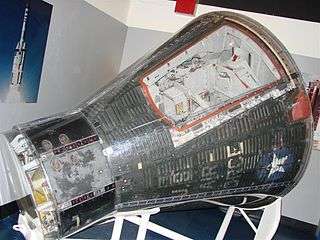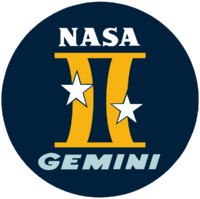Gemini SC-2
Gemini SC-2 (Spacecraft No. 2) was the second NASA Project Gemini full-up space capsule built. This McDonnell Gemini capsule was the first space capsule to be reused, flying twice into suborbital space. No.2 flew on missions Gemini-Titan 2 and Manned Orbiting Laboratory Gemini-B flight. The capsule is currently on display at the Air Force Space and Missile Museum at Cape Canaveral Air Force Station on the Space Coast of Florida, United States.[1]
| SC-2 | |
|---|---|
 | |
| Gemini SC-2 on display | |
| Type | Space capsule Test article |
| Manufacturer | McDonnell |
| Manufactured | 1964 |
| First flight | Gemini-Titan 2 (January 19. 1965) |
| Last flight | MOL Gemini-B 1 (November 3, 1966) |
| Flights | 2 |
| Preserved at | National Air & Space Museum |
Spacecraft history
The capsule is part of the collection of the National Air and Space Museum of the Smithsonian Institution.[2]
On 19 January 1965, the Gemini-Titan 2 suborbital test mission was launched, with the second prototype Gemini capsule.[3][4]
In March 1965, NASA approved the transfer of the Gemini 2 capsule to the USAF for modification into the first prototype of the Gemini B capsule.[5]
On 3 November 1965, the first Manned Orbiting Laboratory (MOL) and Gemini B suborbital test mission was launched.[5] Thus, if you don't count the Mercury capsule used on flights Mercury-Redstone 1 and Mercury-Redstone 1A, the Mercury capsule used on test flights Little Joe 5A and Little Joe 5B, or the Mercury capsule used on flights Mercury-Atlas 3 and Mercury Atlas 4, it became the only Mercury, Gemini, or Apollo, capsule to be reflown.[6] It is also the first capsule to ever be flown twice in space.[7]
The capsule was transferred to the Smithsonian Institution, as part of the National Air and Space Museum collection.[2]
The a mock-up of the Gemini B capsule was put on display in the Allan and Malcolm Lockheed and Glenn Martin Space Gallery at the National Museum of the USAF in 2016.[2]
The flown Gemini SC-2 capsule was put on display in the exhibit hall of the Air Force Space and Missile Museum of the USAF in 2017.[3]
Flight history
| Flight # | Mission | Launch date (UTC) | Liftoff | Landing | Notes | |
|---|---|---|---|---|---|---|
| 1 | Gemini 2 | 19 January 1965 |  |
 |
NASA Mission | [3][4][5] |
| 2 | OPS 0855 | 3 November 1966 |  |
USAF Mission; first spacelaunch reuse of a previously spacelaunched vehicle | [3][4][5] | |
See also
- Falcon 9 booster B1021 – the first Falcon 9 first stage booster to be reused for a space launch mission
- McDonnell Douglas DC-X – Prototype single-stage-to-orbit rocket
- New Shepard – Rocket developed by Blue Origin
- SpaceShipOne – Suborbital air-launched spaceplane
- Dragon C106 – the first Dragon capsule to be reused for a spaceflight mission
References
- USAF (23 May 2020). "Gemini Spacecraft". National Museum of the U.S. Air Force.
- USAF (4 April 2016). "Gemini Spacecraft". National Museum of the U.S. Air Force.
- USAF (2017). "Gemini Capsule". Air Force Space and Missile Museum.
- "Gemini-B: NASA-Gemini's Air Force Twin" (PDF). Historic Space Systems Infosheet. No. 1. Historic Space Systems. September 1996.
- Amy Shira Teitel (3 November 2015). "The Manned Orbiting Laboratory the Air Force Failed to Launch". Popular Science.
- James Dean (3 November 2016). "50 years ago, Air Force 'MOL' program launched only mission". Florida Today.
- Terry Roen (3 November 2016). "Air Force celebrates 50th anniversary of Gemini launch". Orlando Rising.
Further reading
- "Gemini-B: NASA-Gemini's Air Force Twin" (PDF). Historic Space Systems Infosheet. No. 1. Historic Space Systems. September 1996.
- James M. Grimwood; Barton C. Hacker; Peter J. Vorzimmer. Project Gemini: Technology and Operations: A Chronology. NASA. SP-4002.CS1 maint: uses authors parameter (link)
- Carl Berger (1970). History of the Manned Orbiting Laboratory Program (MOL) (PDF). MOL Program Office. Department of the Air Force (USA). BYE-68204/70.
External links
| Wikimedia Commons has media related to Gemini spacecraft No. 2. |
- "Index, Declassified Manned Orbiting Laboratory (MOL) Records". National Reconnaissance Office (U.S. NRO). 22 October 2015. Archived from the original on 29 January 2018. Retrieved 31 December 2017.
